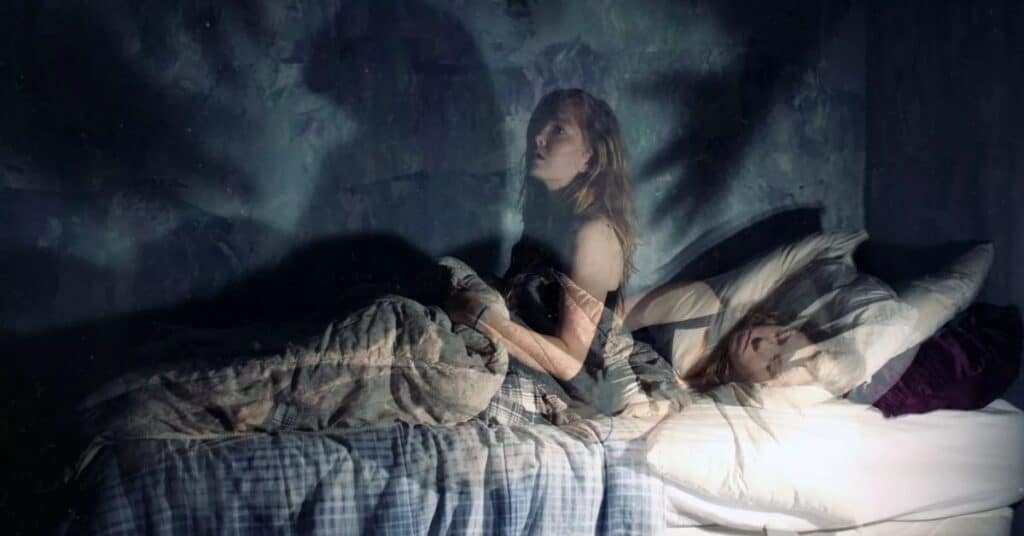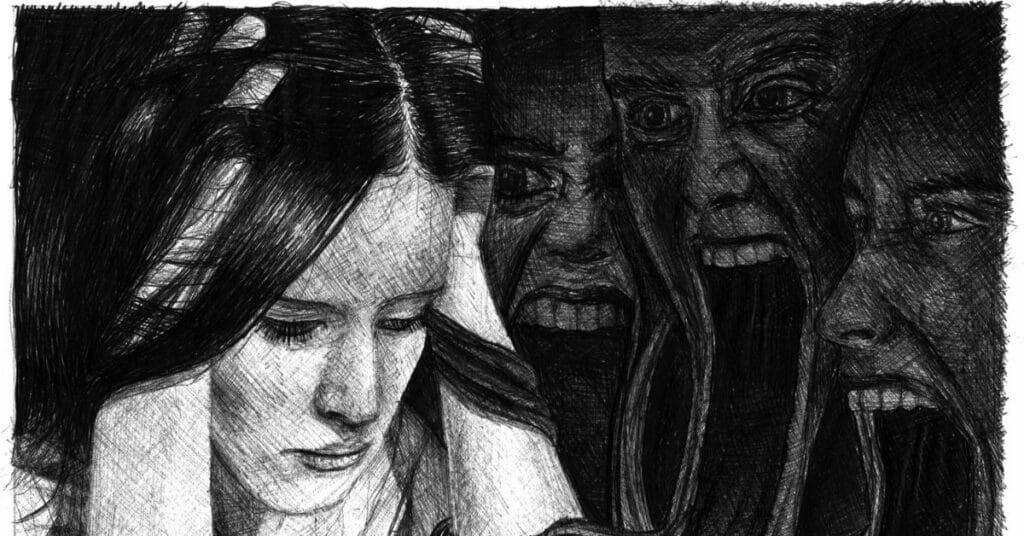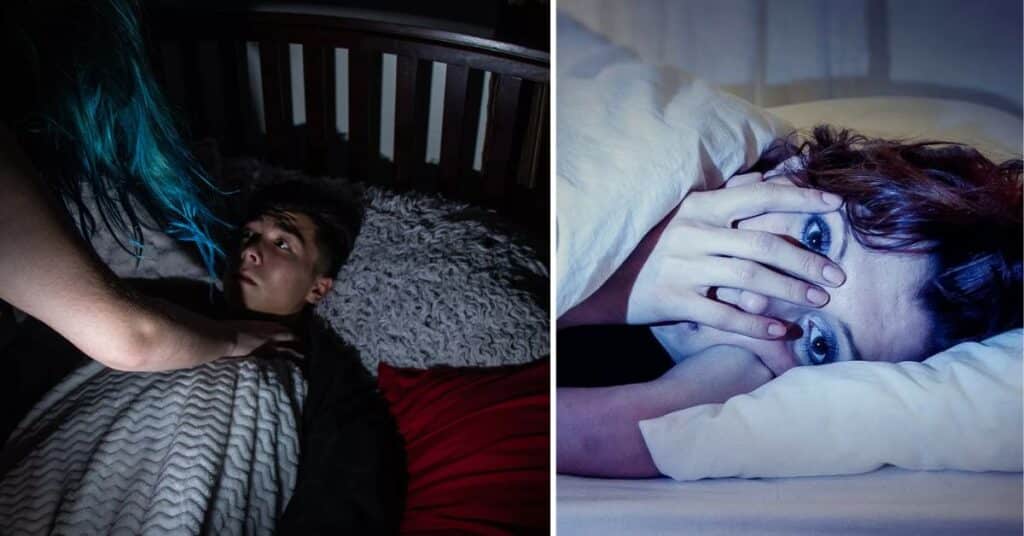The Sleep Paralysis Demon is a scary experience some people have when they wake up but can’t move. It feels like something heavy is on top of them.
This happens because their brain gets stuck between sleeping and waking up. Many people see scary things like monsters or ghosts during sleep paralysis.
It can be terrifying, but it’s not real. Sleep paralysis demons are just tricks of the mind. It’s important to know that they can’t hurt you.
What is the demon of sleep paralysis in Islam?
In Islam demon of sleep paralysis is called “Jinn”. It’s believed to be a supernatural being made of smokeless fire. “Jinn” is thought to inhabit a parallel world to humans.
During sleep paralysis some people may experience encounters with “Jinn” which can be terrifying. It’s important to remember that these experiences are influenced by cultural beliefs and are not necessarily real.
What is the reason for sleep paralysis in Islam?
Sleep paralysis in Islam is commonly associated with the influence of “Jinn”. This is a spiritual entity mentioned in Islamic scripture.
According to Islamic beliefs “Jinn” can interact with humans and may cause disturbances during sleep. That leads to feelings of paralysis and terrifying experiences.
Muslims may seek protection from such occurrences through prayers recitation of specific verses from the Quran and maintaining a state of spiritual cleanliness.
Islamic teachings emphasize the importance of maintaining good sleep hygiene and managing stress to reduce the likelihood of experiencing sleep paralysis episodes.
What’s a Sleep Paralysis Demon?

A sleep paralysis demon is like a spooky movie scene. It feels like something’s pressing down on you. But it’s all in your head. The demon is just a hallucination. Many people have experienced it.
During sleep paralysis you feel trapped. Your body is asleep but your mind is awake. It’s a strange feeling. But it’s not real. It’s a trick of the mind.
Some people see a shadowy figure. Others feel like they’re being held down. It can be terrifying. But remember it’s temporary. You will wake up eventually. Try to stay calm.
There’s no need to be afraid. Sleep paralysis demons aren’t harmful. They can’t hurt you. Take deep breaths and wait for it to pass.
If you’re struggling with sleep paralysis, seek help. Talk to a doctor or therapist. They can offer support and advice. You’re not alone in this experience. Many others have been through it too.
Demon depictions
Demon depictions in stories and art vary widely. Some people imagine demons as dark shadowy figures that lurk in the night. Others picture them as terrifying creatures with sharp claws and glowing eyes.
In folklore demons are often portrayed as evil spirits or monsters that haunt people’s dreams. They may take on different forms depending on cultural beliefs and traditions. These depictions can be influenced by myths legends and religious teachings passed down through generations.
Paralysis Demon

Paralysis demon is a frightening figure people see during sleep paralysis. It’s just a hallucination caused by the brain’s confusion between wakefulness and REM sleep.
Fictional Entity:
The paralysis demon is a fictional entity often associated with the phenomenon of sleep paralysis.
Malevolent Presence:
It is depicted as a malevolent being that immobilizes individuals during episodes of sleep paralysis, instilling a sense of fear and helplessness.
Cultural Variations:
The concept of a paralysis demon varies across cultures and folklore, with different interpretations of its appearance and intentions.
Perceived Presence:
Many individuals who experience sleep paralysis report sensing a menacing presence or seeing a shadowy figure in the room, which they interpret as the paralysis demon.
Real Impact:
While the paralysis demon itself is not real, the fear and distress associated with sleep paralysis can have a significant impact on individuals who experience it.
Read This Blog: ARE PLEATED CURTAINS IN STYLE
Hallucinations

Hallucinations are when your brain tricks you into seeing or hearing things that aren’t real. They can happen when you’re falling asleep or waking up and sometimes during sleep paralysis. It’s like your mind is playing a trick on you, making things seem real when they’re not.
Perceptual Distortions:
Hallucinations are perceptual distortions that involve seeing, hearing, feeling, or smelling things that are not actually present.
Sleep-Related Hallucinations:
Hypnagogic and hypnopompic hallucinations are common during the transitional stages of wakefulness and sleep. These hallucinations can occur during sleep paralysis episodes.
Visual and Sensory Experiences:
Hypnagogic hallucinations often involve vivid visual experiences, while hypnopompic hallucinations may include auditory, tactile, or olfactory sensations.
Dream-like Phenomena:
Hallucinations during sleep paralysis can resemble dream-like phenomena, with individuals perceiving surreal or frightening images and sensations.
Brain Mechanisms:
Hallucinations during sleep paralysis are believed to arise from disruptions in the brain’s processing of sensory information and its transition between sleep states.
Are these ‘demons’ real?
No sleep paralysis demons are not real creatures. They are hallucinations caused by glitches in the brain’s sleep wake transition.
While they may feel terrifyingly real during an episode of sleep paralysis. They are simply a product of the mind’s confusion between dreaming and wakefulness.
What Happens During Sleep Paralysis Demon?

During sleep paralysis the body becomes temporarily paralyzed while the mind remains awake. This can lead to intense fear and feelings of being trapped.
Delusions including demonic entities can occur during this state. Which adds to the feeling of terror and helplessness.
Scientific Explanations Of Sleep Paralysis
Scientists explain sleep paralysis as a glitch in the transition between sleep stages. During REM sleep the body’s muscles become temporarily paralyzed to prevent acting out dreams.
In sleep paralysis this paralysis persists even as the mind becomes partially awake leading to a sensation of being unable to move.
Hallucinations during this state are attributed to the brain’s attempt to make sense of the unusual experience, often manifesting as terrifying entities like demons or intruders.
The History Of Sleep Paralysis Demons
Throughout history various cultures have depicted sleep paralysis demons. These entities are often described as malevolent beings that cause paralysis and induce fear.
From ancient folklore to modern interpretations sleep paralysis demons have been a recurring theme in human storytelling.
Causes Of Sleep Paralysis Demons

Sleep paralysis demons can be triggered by various factors. These may include disrupted sleep patterns stress anxiety and sleep disorders like narcolepsy.
Other potential causes include sleep deprivation irregular sleep schedules and certain medications. Understanding these factors can help individuals manage and reduce the occurrence of sleep paralysis demons.
Possible Treatments And Prevention Of Sleep Paralysis
Treatment for sleep paralysis demons involves improving sleep habits and reducing stress. Try relaxation techniques and maintain a regular sleep schedule
Avoid alcohol caffeine and heavy meals before bedtime. Manage anxiety with cognitive behavioral therapy (CBT).
Eliminate Distractions
- Dim the lights and minimize noise in your bedroom.
- Avoid using electronic devices before going to bed.
- Set up a serene atmosphere to promote restful sleep.
- Turn off TVs and phones
- Keep the bedroom quiet and dark
- Relax before bedtime
6-8 Hours Of Sleep
- Strive to sleep for 6 to 8 hours every night.
- Maintain a consistent sleep schedule.
- Create a relaxing bedtime routine to promote better sleep.
- Ensure your sleep environment is comfortable and conducive to rest.
- Avoid caffeine heavy meals and stimulating activities before bedtime.
No food, alcohol or caffeine before bed
- Avoid consuming food alcohol or caffeine close to bedtime.
- These substances can disrupt your sleep and increase the likelihood of sleep paralysis.
- Opt for lighter snacks if you feel hungry before bed.
- Limit alcohol and caffeine intake earlier in the day to minimize their effects on sleep.
- Stick to water or herbal tea in the evening to promote better sleep quality.
Avoid Napping
- Refrain from taking naps during the day.
- Napping can disrupt your sleep pattern and increase the risk of sleep paralysis.
- Instead of napping, try engaging in light physical activity or taking a short walk to combat midday fatigue.
- Establish a consistent sleep schedule to reduce the need for naps.
- Prioritize nighttime sleep to ensure adequate rest and minimize the occurrence of sleep paralysis episodes.
Don’t sleep on your back
- Avoid sleeping on your back to reduce the likelihood of experiencing sleep paralysis.
- Sleeping on your back can increase the risk of snoring and disrupt your sleep cycle.
- Opt for sleeping on your side or in a different position to promote better sleep quality.
- Experiment with various sleeping positions to find the most comfortable and effective posture.
- Maintain proper sleep hygiene practices to minimize the occurrence of sleep paralysis episodes.
Frequently Asked Questions
How common is sleep paralysis?
Sleep paralysis affects about 8% of the population, with some studies suggesting up to 30% experience it at least once in their lifetime.
Are sleep paralysis demons real?
Sleep paralysis demons are hallucinations resulting from the brain being stuck between sleep and wakefulness; they are not real entities.
Can sleep paralysis be prevented?
While it cannot always be prevented, reducing stress, maintaining a regular sleep schedule, and creating a calm sleep environment may help reduce the frequency of sleep paralysis episodes.
Final thoughts
Sleep paralysis demons can be frightening, but understanding them helps alleviate fear. By learning about the science behind sleep paralysis individuals can feel more empowered and less anxious when experiencing it.
With awareness of the causes and triggers of sleep paralysis, people can take proactive steps to prevent it. Managing stress and maintaining regular sleep patterns are crucial for reducing the occurrence of sleep paralysis demons. Overall knowledge and proactive measures can help individuals navigate this phenomenon with greater confidence and peace of mind.







